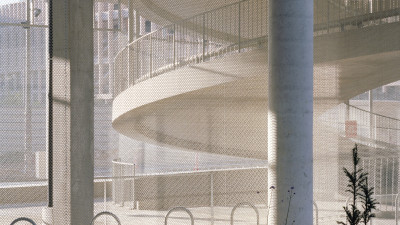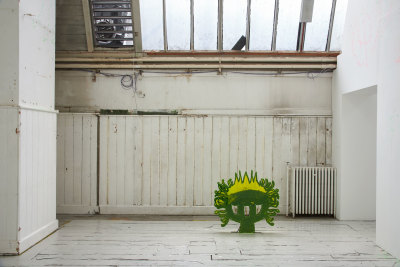The month in architecture
The month in architecture
Everything you need to know that happened in July 2015
By Helena Cuss
Published 31 July 2015
The biggest architecture news, the latest prizes and the wackiest new projects – rounded up into one handy post each month.
-
1. Beyoncé-shaped skyscraper for Melbourne
Last month we reported on the unconventional new shapes being dreamed up by architects to reinvent the iconic skyscraper. This month, an Australian firm have gone one step further: Elenberg Fraser have designed a 226m-high tower inspired by the famously curvaceous body of pop singer Beyoncé. The sinuous undulations of the building directly reference the fabric-wrapped bodies of dancers in the star’s music video, Ghost. Don’t be fooled by the atmosphere of fun though: the architects firmly believe that the alternating bulges are an effective way of producing the correct wind requirements and structural dispersion for the building.See more about the project on the architects’ website.
2. Controversy over No. 1 Poultry redevelopment
A host of furious architects have written to Historic England to request that the famous post-modern office building, No. 1 Poultry, designed by the great British architect James Stirling, be given a Grade-II* listing. The original design team, Lord Palumbo (the developer who commissioned the building in the 1970s), as well as Royal Academicians Richard Rogers, Norman Foster and Zaha Hadid, wrote that architecture firm Buckley Gray Yeoman’s redevelopment plans, which include changing the alignment of the windows, are “insulting to […] James Stirling’s rigorous concept which struck a carefully crafted balance between all user requirements”. The Twentieth Century Society, which campaigns for the preservation of British architecture from 1914 onwards, have also called for No. 1 Poultry’s listing.
-

Premier Tower, Melbourne

No. 1 Poultry, London

NEO Bankside, London, by Rogers Stirk Harbour + Partners

University of Greenwich Stockwell Street Building, London – interior, by heneghan peng architects
-
3. World’s first bee highway in Oslo
In Norway’s capital city, environmental group Bybi is creating a “bee highway” to protect the increasingly endangered species. Across the city, offices, schools and private individuals are transforming small patches of their outdoor spaces into beds of sunflowers, marigolds and other nectar-rich plants, which act as feeding stations for the bees, and form a network of safe passage through the city. Organisers are hopeful that the scheme will catch on in the US and other European countries, where bee populations and biodiversity are much more aggressively threatened by intensive pesticidal agriculture.Find out more on Bybi’s website.
4. Paris to get first skyscraper since 1970s
Paris is a city notoriously resistant to high-rise development, but Swiss architects Herzog & de Meuron have finally won planning permission to build their much-debated Tour Triangle. The pyramidal skyscraper will stand at 180m, towering over its neighbours in the Porte de Versailles area, and will be the third largest building in Paris after the Eiffel and Montparnasse towers. The latter caused major controversy upon completion in 1973, which triggered the strict new limits posed on building heights in the city up until now.Read more on Herzog de Meuron’s project page.
5. Stirling Prize 2015 shortlist announced
The Stirling Prize, launched by the Royal Institute of British Architects in 1996, is widely considered as one of British modern architecture’s greatest accolades. This year’s shortlist sees the return of architectural giants – including two-time winner Richard Rogers RA – as well as lesser-known first-timers; firm MUMA for their Whitworth Gallery extension in Manchester and Reiach & Hall for their Maggie’s centre in Lanarkshire. Entries in the capital include Niall McLaughlin’s housing scheme in East London, Heneghan Peng’s university building in Greenwich, and Allford Hall Monahghan Morris’s school in Tooting. RIBA President Stephen Hodder explained that the shortlisted projects were chosen for being “surprising new additions to urban locations”.Discover past and present Stirling Prize winners on the RIBA website.
-

Maggie’s Lanarkshire – exterior, by Reiach and Hall Architects

Maggie’s Lanarkshire – interior, Reiach and Hall Architects

Darbishire Place, London, by Niall McLaughlin Architects

Burntwood School, London, by Allford Hall Monaghan Morris
-
6. Chancellor re-writes planning rules
George Osbourne has announced unexpected new plans to give developers access to brownfield sites for housing in London (potential sites for building development in urban areas, that have previously been developed). A new zonal system will give automatic planning permission “in principle” on suitable sites, if local councils have failed to provide a plan. The first database of brownfield land available for housing in London is expected to be completed by the end of the year, and the plans also devolve powers further to London Mayor Boris Johnson, who is heading up the London Land Commission with a view to building 500,000 in the next 10 years. The Conservative government hopes that the move will force local councils to “plan proactively” for housing and discourage “nimby-ism” among residents, but critics claim that it’s a U-turn on the Conservative’s manifesto commitment to increased localism.Read the official statement from the government here.
7. First energy-positive house built in Britain
On the edge of an unassuming Welsh industrial estate, a team from the Welsh School of Architecture, led by Professor Phil Jones, has designed and built a house which can generate more electricity than it consumes. It is the first of its kind in Britain. The three-bedroom house cost just £125,000 and took under 16 weeks to build. With a roof made from solar panels and hefty insulation for the winter months, it is expected to generate £175 of electricity for every £100 of electricity used. It was built to meet the low carbon housing targets set by the Labour government in 2006, and recently scrapped by Chancellor George Osbourne.Find out more from the Low Carbon Research Insititute website.
-

The Whitworth Gallery, Manchester – exterior, by MUMA

The Whitworth Gallery, Manchester – interior, by MUMA

University of Greenwich Stockwell Street Building, London – exterior, by heneghan peng architects

SOLCER house, Wales















